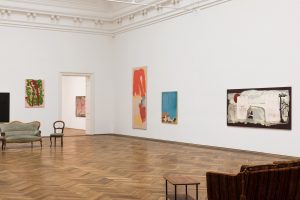The Kunsthalle Basel is one of those institutions that never disappoints even when it offers exhibitions with less established authors, or those we still don’t know how to recognize. It will be for the beauty of the architectural space (with an ancient aura but at the same time very clean and simple), it will be for the ability of the staff of the institution in taking care of the installations or for the capacity of constructive dialogue that is established with each author who it is hosted there, the fact is that each exhibition is always surprising, varied, different from one another, so much so that it is a joy to be able to visit this sanctuary of contemporary art from time to time.
This premise is valid and is also confirmed with the exhibition by Michaela Eichwald, currently ongoing. The author, while not boasting a very significant curriculum (we recall incidentally some of these stages: Palais de Tokyo, Paris, 2014; Isabella Bortolozzi in Berlin and Maureen Paley in London, 2018; Lenbachhaus, Munich and Walker Art Center, Minnesota, 2020), and despite not having obtained a traditional artistic training, in the sense that she studied philosophy, history, art history and German philology and everything she learned as basic elements of technical doing depended on informal acquaintances with artists a little older than her, such as Cosima von Bonin and Jutta Koether, she made these shortcomings a point of redemption and affirmation. Thus, with a conscience fully in line with Duchampian principles (where thought counts more than process, where indicating counts more than manual skills), after a series of experimental paths and attempts in the field of video art and photography, she arrived at pictorial narration, without worrying about having to respect the basic foundations of an adequate academic preparation, but only with an immense desire to try her hand and to confront herself, given that she certainly does not lack conceptual motivations and first-hand information.
Here we are, then, in the beautiful rooms of the Kunsthalle Basel in front of these canvases, these completely new and unpublished works that explode in their energy, made on supports such as leatherette or polyurethane (without any prepared background) and with unconventional pigments ( such as shellac, spray, fake blood, graphite, marker, stickers, glitter). On these large surfaces, the author lets shapes float (as if abandoned to a constant current) that refer to intestinal tracts or to the bodies of jellyfish: shapes that are attractive for their sinuosity and repulsive at the same time for what they tend to evoke. Yet the point is not only that of the support and the vaguely expressionist system profiles that are rampant in that field, but also of how these “canvases” are “mistreated”, in a way that characterized the most significant work of Munch and which can lead the work towards a result that is not always predictable, so much so that rule and chance can coexist in a tight and predetermined duet. The simplicity of the proposal may seem disarming, however at the same time it refers to a depth that makes us understand that complex and difficult to understand rules are not always the most important aspect of our world: sometimes you have to go back down to earth and beat them to feel the ground under your shoes. In this sense, the emblematic phrase pronounced by the author is: “I paint these pictures for anyone who wants to look at them”. And to make this look possible, to bring it closer to a familiarity that is not always easy to obtain within an exhibition space, often aseptic and not involving, here is the arrangement of chairs, sofas, tables, as if to create a parallel and of relationship between the work placed on the wall and the object scattered in the space.
To put it another way and to close this reasoning, I would refer to the lines of Danielle Collobert: “être ici – le calme – épuisant de tension – le monde autour qui ne s’arrête pas – mais pourrait s’arrêter – le souffle qui pourrait s’arrêter maintenant – un instant après l’Autre – même égalité plane – même dureté froide – même goût fade et doux – supporter encore d’aller vers d’autres moments pareils – continuer seulement le souffle – la respiration – prolonger le regard – simplement “. And again: “des références – des repères – un autour – au-dehors – pas pour l’Instant – plus tard – une fois passé l’angoisse – moment immobile – arrêter là – mémoire brisée à cet instant – voix seule dans le silence – des mots – et plus d’attente “.
Maddalena B. Valtorta
Info
Michaela Eichwald, Auf das Ganze achten und gegen die Tatsachen existieren
8/10/2021 – 23/01/2022
Kunsthalle Basel
Steinenberg 7
CH-4051 Basilea
T +41 61 206 99 00
info@kunsthallebasel.ch
 Michaela Eichwald, Auf das Ganze achten und gegen die Tatsachen existieren, installation view, Kunsthalle Basel, 2021. Ph. Nicolas Gysin / Kunsthalle Basel
Michaela Eichwald, Auf das Ganze achten und gegen die Tatsachen existieren, installation view, Kunsthalle Basel, 2021. Ph. Nicolas Gysin / Kunsthalle Basel
 Michaela Eichwald, Auf das Ganze achten und gegen die Tatsachen existieren, installation view, Kunsthalle Basel, 2021. Ph. Nicolas Gysin / Kunsthalle Basel
Michaela Eichwald, Auf das Ganze achten und gegen die Tatsachen existieren, installation view, Kunsthalle Basel, 2021. Ph. Nicolas Gysin / Kunsthalle Basel
 Michaela Eichwald, Gibt es denn wirklich nichts Schönes, nichts Schöpfungsbejahendes mehr?, 2020, acrylic and lacquer on polyurethane fabric 135.5 x 95.5 cm. © Michaela Eichwald, courtesy Maureen Paley, London/ Hove
Michaela Eichwald, Gibt es denn wirklich nichts Schönes, nichts Schöpfungsbejahendes mehr?, 2020, acrylic and lacquer on polyurethane fabric 135.5 x 95.5 cm. © Michaela Eichwald, courtesy Maureen Paley, London/ Hove

is a contemporary art magazine since 1980






NO COMMENT